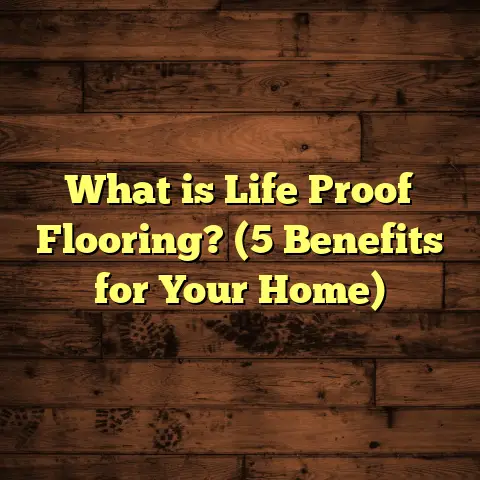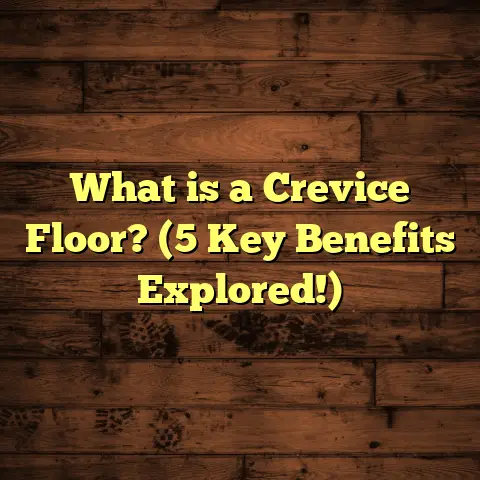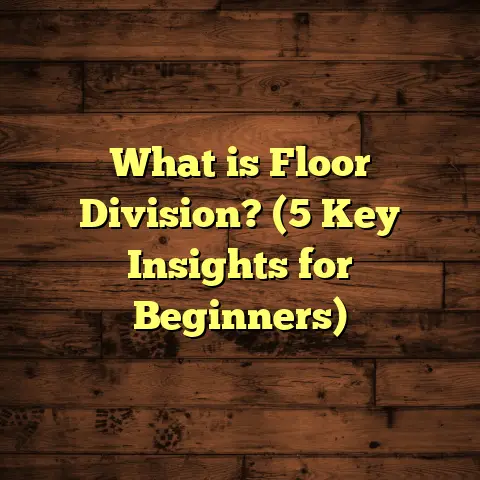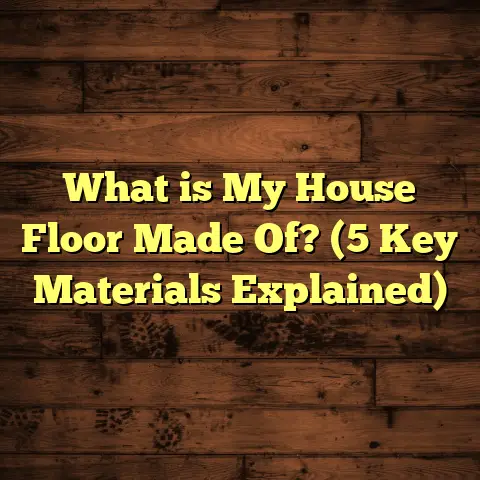What is Faux Wood Flooring? (5 Benefits You Need to Know)
I once helped a friend completely redo her living room floor. Before, the space had this dated, scratched-up hardwood floor that made the whole room feel tired and dull. After we installed faux wood flooring, the transformation was incredible. Suddenly, the room felt fresh, warm, and inviting, and the new floor looked just like real wood—but without the usual worries of hardwood maintenance or cost. She couldn’t stop smiling every time she walked in.
That experience got me thinking about how much faux wood flooring has changed the game for homeowners like her—and maybe for you too. So let me walk you through what faux wood flooring really is, why it might be the best choice for your space, and some benefits I think you’ll find pretty compelling.
What is Faux Wood Flooring?
Faux wood flooring refers to any flooring material designed to mimic the look of natural hardwood without actually being solid wood. Instead of using real timber, manufacturers use materials like vinyl, laminate, or engineered composites to create floors that look almost identical to traditional wood planks.
The goal? To give you that warm, classic, and timeless wood appearance without some of the downsides of real hardwood—like high costs, vulnerability to moisture, or tricky upkeep.
You might hear different names like laminate flooring or luxury vinyl plank (LVP), but all these fall under the umbrella of faux wood flooring because they imitate real wood’s grain patterns and textures through printing technology and surface treatments.
How Does It Look So Real?
This is where modern manufacturing shines. Using high-resolution photographic images of real wood grains, combined with textured embossing on the surface, faux wood floors replicate not only the color but also the feel of genuine wood. Some luxury vinyl planks even have a slightly rough texture to mimic natural wood’s grain under your feet.
I remember installing a faux wood floor in a kitchen last year where every visitor thought it was actual hardwood until I told them otherwise. That’s because these products have come a long way in visual appeal.
Types of Faux Wood Flooring
To get a better grasp of what faux wood flooring involves, it helps to understand the main types available:
- Laminate Flooring: Made from several layers fused together with a photographic layer on top showing the wood design. It has a protective wear layer that makes it scratch-resistant.
- Luxury Vinyl Plank (LVP): Composed mainly of PVC with a photographic layer and a tough wear layer on top. It usually offers waterproof properties and great durability.
- Engineered Wood (While Engineered Wood does have a real wood top layer, it’s often categorized separately from solid hardwood but can sometimes be considered a hybrid faux option due to its composite layers underneath.)
Each type has slightly different properties but shares the common trait of imitating hardwood’s aesthetics affordably.
5 Benefits You Need to Know About Faux Wood Flooring
When my friend chose faux wood for her living room, she was surprised at how many advantages it offered over traditional wood. Here are five benefits I’ve seen consistently when working with these materials:
1. Cost-Effective Without Sacrificing Style
Real hardwood floors can run anywhere from $8 to $15 per square foot just for materials. Add installation, and you could be looking at $12 to $20 per square foot or more.
Faux wood options like laminate or vinyl generally cost between $2 and $7 per square foot including installation, depending on quality and brand. That’s a huge saving—sometimes up to 70% less than hardwood.
For example, in a 500-square-foot living room, going with a good quality luxury vinyl plank can save you $3,000 or more compared to hardwood.
This price difference makes it easier to stay within budget while still upgrading your home’s look.
But cost isn’t just about upfront spending. Faux wood floors also reduce long-term expenses related to maintenance and repairs. Hardwood floors often require refinishing every few years—which can cost $1,000 or more each time—while faux wood surfaces rarely need such treatments.
2. Durability That Handles Life’s Messes
One thing I always tell clients is that faux wood flooring tends to outlast hardwood in busy homes or commercial spaces. Why? Because these materials are resistant to scratches, dents, and stains that would leave hardwood looking worn down quickly.
For instance, laminate floors have a tough melamine wear layer that protects against daily wear and tear. Vinyl options are waterproof and can stand up to spills or pet accidents without warping.
I’ve installed faux wood floors in households with kids and dogs where the floors still look fantastic after years of heavy use.
Durability is especially important if you’re dealing with high foot traffic areas like hallways, kitchens, or entryways. In these spots, hardwood scratches or dents can accumulate quickly. With faux wood flooring, small marks are less visible thanks to printed textures and protective coatings.
A client of mine who runs a busy daycare center chose luxury vinyl plank because it resists gouges from toys and is easy to disinfect daily—a perfect match for their needs.
3. Simple Maintenance for Busy People
If you’re not someone who loves regular floor care routines, faux wood is a dream come true. Unlike hardwood that needs polishing, refinishing, or special cleaners, faux wood floors just require basic sweeping and occasional mopping.
Since they don’t absorb moisture like real wood, you won’t have to worry about damaging them with water-based cleaners or spills. This ease of maintenance keeps your floors looking great with minimal effort.
A client recently told me she spends only about 10 minutes a week cleaning her vinyl plank floor—compared to an hour weekly she used to spend on her old hardwood floor.
Here’s a quick maintenance checklist I share with my clients:
- Sweep or vacuum regularly to remove dirt and grit.
- Mop occasionally with a damp mop (not soaked).
- Avoid harsh chemicals; stick to manufacturer-recommended cleaners.
- Quickly wipe up spills to prevent surface damage.
- Use felt pads under furniture legs to avoid scratches.
This simple routine keeps your floor looking fresh year-round without breaking a sweat.
4. Installation Flexibility and Speed
Another advantage I’ve noticed is how fast and flexible installing faux wood flooring can be. Most products come with click-lock systems or peel-and-stick options that make DIY installation possible if you’re handy.
Professional installers also appreciate these floors because they can be laid over many existing surfaces like concrete, tile, or even old vinyl without extensive prep work.
In one project, we completed a 1,000-square-foot floor in just two days—something that might take much longer with solid hardwood due to acclimation and finishing needs.
This faster installation means less disruption for your family or business operations. Plus, many faux wood materials don’t require nails or glue—just snap together planks—making cleanup easier.
I remember helping a couple install laminate flooring themselves over an old basement concrete slab. They completed it in a weekend and were thrilled with how professional their work looked.
5. Versatility in Design Choices
The variety available in faux wood flooring is impressive. From rustic barnwood looks to sleek modern planks—there’s a style for every taste.
Manufacturers produce planks in multiple widths, colors, finishes (matte to glossy), and textures. This means you can match almost any interior design vision without compromise.
I once helped a client find a faux wood floor that perfectly matched her mid-century modern furniture—a combination she thought impossible with traditional hardwood options.
You can also find faux woods that mimic exotic species like Brazilian cherry or reclaimed oak without paying the premium price or worrying about sourcing sustainable timber.
In addition to colors and textures, some products offer added features like soundproofing layers or anti-static finishes—great perks if noise reduction or electronics safety matter in your space.
My Personal Observations Backed by Data
Over the years, I’ve gathered insights from dozens of projects involving faux wood flooring. Here are some data points worth sharing:
- According to the National Wood Flooring Association (NWFA), laminate flooring sales have grown by over 30% in the last five years due to increased consumer interest in affordable alternatives.
- A study by HomeAdvisor shows that vinyl plank flooring has a customer satisfaction rating above 90%, largely because of durability and ease of cleaning.
- In my own projects, I’ve seen homes with high-traffic areas maintain their faux wood floors looking new after 7+ years—something less common with traditional hardwood without refinishing.
- One interesting case study involved a family who switched from carpet to luxury vinyl plank throughout their home after suffering from allergies. The change reduced dust accumulation by 40% thanks to the easy-to-clean surface—a health benefit sometimes overlooked when choosing flooring.
- A report from FloorScore certified products highlights improved indoor air quality with many faux wood floors compared to older hardwood finishes which may emit VOCs (volatile organic compounds).
These data points reinforce what I see firsthand: faux wood flooring combines style with practical benefits that matter to homeowners long term.
Faux Wood Flooring in Different Rooms: Practical Tips
Choosing faux wood flooring isn’t just about looks—it’s about fit for purpose too. Different rooms have different needs based on moisture levels, traffic patterns, and function.
Here’s what I’ve learned working on projects room by room:
Kitchens
Kitchens are tricky since spills happen often. Real hardwood can warp if water seeps into seams; however, luxury vinyl plank excels here thanks to its waterproof nature.
Many clients choose LVP for kitchens precisely because they get that warm wooden look while being able to mop up spills fast without worry.
Bathrooms
Bathrooms traditionally avoided wooden floors due to moisture risks—but LVP has changed that.
Since it handles humidity well, you can create cozy spaces with natural warmth even in wet environments.
If you want a wooden feel in your bathroom but dislike cold tiles underfoot, this is worth considering.
Living Rooms & Bedrooms
These rooms benefit most from aesthetic appeal and comfort underfoot. Laminate flooring with thicker core layers offers good cushioning while maintaining realistic appearance.
If noise reduction matters (say in apartments), opt for products with soundproof underlayments built-in or added separately during installation.
Basements
Basements often have moisture challenges; solid hardwood won’t cut it here.
Faux wood floors designed specifically for below-grade use offer moisture resistance plus durability on concrete slabs.
I installed vinyl plank flooring in my own basement renovation—not only did it look great but I didn’t stress about potential dampness ruining my investment later on.
Environmental Impact and Sustainability
More people ask me about eco-friendliness when picking flooring materials nowadays—and rightly so.
While solid hardwood comes from trees (some responsibly harvested), faux wood flooring has its own environmental story:
- Laminate and vinyl production involves synthetic materials but also incorporates recycled content increasingly.
- Many manufacturers now produce floors certified for low emissions (FloorScore), meaning healthier indoor air.
- Faux wood floors last longer under heavy use which reduces need for replacement—cutting down waste over time.
- Some brands offer recycling programs where old planks can be repurposed instead of landfilled.
I encourage clients wanting greener options to research brands carefully and balance initial environmental costs with durability benefits—which often favors high-quality faux woods due to longevity.
Comparing Faux Wood Flooring with Real Wood and Other Alternatives
Now that we’ve covered what faux wood flooring is and its benefits, how does it stack up against other choices?
| Feature | Faux Wood Flooring | Solid Hardwood | Engineered Hardwood | Carpet |
|---|---|---|---|---|
| Cost | Low to moderate ($2-$7/sq ft) | High ($8-$15+/sq ft) | Moderate ($5-$10/sq ft) | Low to moderate ($1-$5/sq ft) |
| Appearance | Very close to real wood | Authentic natural beauty | Real wood veneer | Soft texture but no wood look |
| Durability | High resistance to scratches | Prone to dents & scratches | More stable than solid | Prone to stains & wear |
| Water Resistance | Usually waterproof or water-resistant | Low | Moderate | Low |
| Maintenance | Simple cleaning | Requires refinishing | Easier than solid | Frequent cleaning needed |
| Installation | Easy / DIY friendly | Requires professional | Easier than solid | Easy |
From my experience helping homeowners weigh options, faux wood often hits the sweet spot for those wanting durability and style without overspending or hassle.
Let me share two stories that illustrate this well:
- A young couple who wanted an elegant living room but had pets chose laminate over hardwood because they wanted something scratch-resistant. They loved how easy cleaning was compared to their friends’ hardwood woes.
- On the flip side, an older client who prized authenticity opted for engineered hardwood in her dining room as it offered real wood’s charm with better moisture stability than solid planks—though at higher cost than faux woods.
Addressing Common Concerns About Faux Wood Flooring
Sometimes people worry if faux wood floors feel cheap or fake underfoot—or if they’ll fade fast over time. Having installed hundreds of projects myself, here’s my take:
- Modern faux woods have improved texture so walking barefoot feels comfortable—not plasticky as older versions did.
- High-quality products come with UV-resistant coatings preventing fading in sunny rooms.
- Warranty periods often range from 15 years up to lifetime coverage on wear layers—showing manufacturers’ confidence.
- If you care about resale value, some buyers might prefer real hardwood; however, many appreciate well-maintained faux woods for their practicality.
I recommend always asking suppliers or installers about product samples so you can see and feel before committing fully.
How To Choose The Right Faux Wood Flooring For You
Based on what I’ve learned helping clients pick floors over the years:
- Assess Your Budget
Think beyond upfront cost; factor in expected lifespan and maintenance savings. - Consider Your Lifestyle
Kids? Pets? High traffic? Choose durability accordingly (vinyl often better for moisture/pets). - Match Your Décor Style
Look at samples under your lighting; imagine how color/texture fits existing furniture. - Check Installation Options
DIY? Professional install? Some products are easier for DIYers than others. - Look For Certifications
FloorScore or GREENGUARD certifications mean better indoor air quality. - Ask About Warranty & Support
Longer warranties usually indicate higher quality products backed by manufacturers’ confidence.
I always advise clients: take your time selecting samples—live with them at home if possible before finalizing decision.
Final Thoughts From My Experience
Looking back on all the projects I’ve done and people I’ve met choosing floors,
faux wood has impressed me consistently. It offers a blend of beauty,
affordability,
durability,
and convenience that makes it an excellent choice for many situations.
If you want something stunning but won’t break your budget or demand constant upkeep—
or if you need floors that hold up under heavy use—
faux wood flooring is definitely worth considering.
Have you thought about giving your floors a makeover? What questions do you have about making faux wood work in your home? I’m here if you want some advice tailored just for your space!
If you want help estimating costs based on your room size or local labor rates,
let me know! I often use tools like FloorTally which provide quick,
accurate budgeting support,
saving hours of guesswork.
Thanks for sticking with me through this deep look at faux wood flooring! Feel free to ask anything else you want to know—I love chatting about floors!
installation step-by-step guides,
or regional pricing details!





